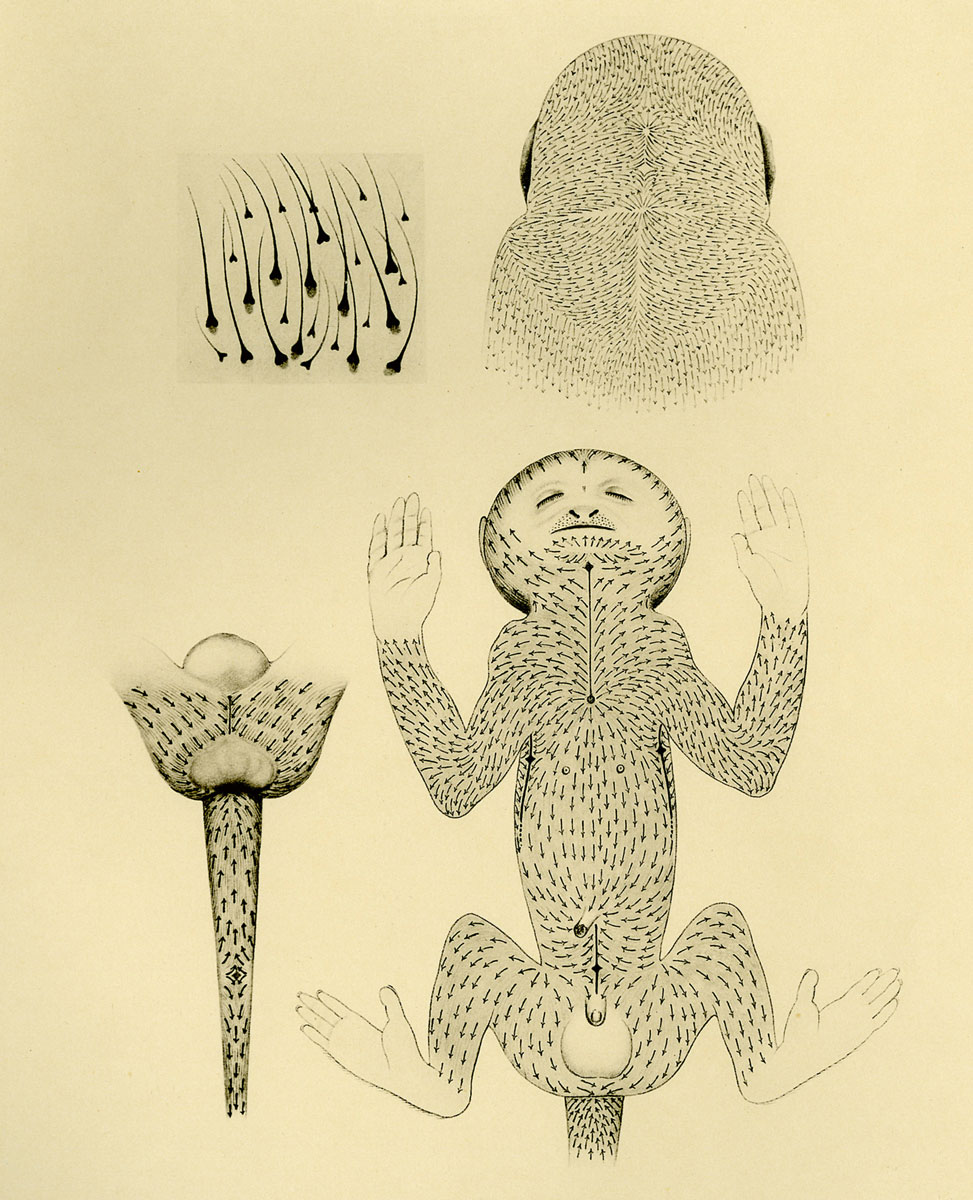
Often invoked as a metaphor of irrationality and confusion, hair in the nineteenth century was also employed as an instrument of scientific precision. From criminological investigations to anthropological inquiries, hair was presented both as material evidence and as a methodological pattern, whose minute accuracy helped scientists direct their research towards the root of a problem. More than texture, form, and color, however, the most revealing quality of hair in scientific research of that period was its direction—hair’s geometric capacity not only to occupy but to delineate space, including the realms of knowledge.
In his 1856 lecture on adornment, the nineteenth-century architect Gottfried Semper used hair and hair ornaments as indicies of spatial direction (Richtung).[1] Hair could be used to form “pendants” (such as the long beards and heavy hair braids of the ancient Assyrians which hang down symmetrically), or “rings” (such as the annular coiffures of ancient Greek women forming a circular corona around the head). But Semper also distinguished a third type of adornment, for which the architect coined the term “directional ornament” (Richtungsschmuck). These adornments accentuated the orientation of a subject in movement, and included the warrior’s fluttering garments, headgear, or windblown hair, as well as the decorated mane of military horses (such as those depicted in the famous reliefs from Nimrud, which Semper would have seen at the British Museum while he was in exile in London).
Drawing from the etymology of the Greek kosmos, which meant world, order, adornment, as well as direction and discipline, Semper bestowed each of his three ornamental categories with a cosmic attribute. While pendants and rings were respectively linked to macrocosmic equilibrium and microcosmic proportion, directional ornaments were representative of a world in flux—a dynamic universe whose human and animal bodies were gradually substituted by the eidetic signs of their accessories. Thread-like appendages such as hair augmented the subject’s corporeal volume while reducing its presence into a transient vector. While singular in direction, the same vector pointed to a manifold transformation. The fabric of the world was constantly changing, and cultural theorists and evolutionists alike attempted to decipher that new texture by dissecting its mobile edges—the appendages of clothing accessories and hair extensions.
One of the many readers of Semper’s essay on adornment was the evolutionist and amateur anthropologist Emil Selenka, who was a colleague of Karl Semper, a professor of morphology and a nephew of the architect. Both scientists had spent a considerable amount of time traveling in the German colonies of Southeast Asia, collecting natural specimens and writing travel memoirs describing their encounters with indigenous cultures in which they analyze the dress, adornment, and hair arrangements of native tribes, including the texture, color, and peculiar mode of hair style.[2]
Selenka eventually wrote a treatise titled The Adornment of People, in which he applied Semper’s categories of rings, pendants, and directional ornaments to adornments from non-Western cultures.[3] The anthropologist would illustrate Semper’s “pendants,” for example, by depicting the long hair braids of Indian fakirs, and directional ornaments by the feather headgears of North American Apaches. However, the most telling of these studies on the “rudimentary” forms of ornamentation were contained in the scientist’s evolutionist studies.
Selenka was the leading scientific authority in the study of “ape-humans” (Menschenapfen) or pithikanthropoi—the various species of primates that preceded Homo sapiens—as well as the main editor of a multi-volume series of comparative studies on the evolution of these species, including the structure of their teeth, bone, and hair. One of these illustrated volumes, titled “On the directionality of hair in ape-embryos” (Affenembryonen), contains a detailed examination of growth patterns in the fur of young apes within the main three primate species.[4]
Scientists had already established that hair grew in geometric patterns that have multiple centers located differently in each species. Evolutionists then followed the direction of hair strands from their origin to their end point in the extremities, tail, face, belly, and anus. The decisive evidence that would lead scientists to a conclusion was in the devilish minutiae down to the level of follicles.
Hair threads move either in a radial or spiral direction from a center; they form “streams,” as indicated in diagrams such as the one presented here, by a series of arrows. These demarcated hair flows emulate electromagnetic currents which can converge or diverge with one another and create ornamental patterns such as crosses and rhomboids. The numerous drawings of young apes traversed by myriad directional arrows transformed the animal body into a force field: a quasi-cosmological diagram expanding inside the outline of a baby monkey. Extremities such as toes and fingers provided an outlet for that proliferating energy to be channeled back into the world. Here, hair is still a form of adornment in Semper’s “cosmic” sense: these minute arrows not only extended the animal body into the world, but also reinscribed all cosmic forces directly on the surface of the animal epidermis. Adornment was no longer an external pendant or a ring, but an entire field of directions by means of which the body realigned itself with the forces that enveloped it.
From the linear symmetry of man in Semper’s physiomorphology of culture to the directional flow of ape hair in the diagrams of turn-of-the-century evolutionists, a cosmological shift had occurred: ornamentation had not disappeared, but retreated to its origins by folding back into the skin—the living vestige of a primal surface.
Spyros Papapetros teaches art, architectural theory, and historiography in the School of Architecture and the Program in Media and Modernity at Princeton University. He is the editor of Siegfried Ebeling’s Space as Membrane (AA Publications, 2010) and has completed a book-length study on turn-of-the-century discourses of animation (forthcoming in 2011).